Mala Gallery
8, Zamkowy Sq., Warsaw (Old Town)
May 10th - June 3rd, 2005
Konrad Pustoła - WARSAW, pinhole photography
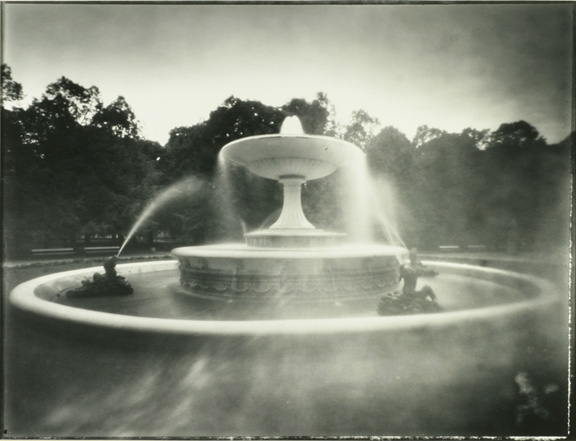
Konrad Pustoła, Saski Gardens, 2002, from series "Warsaw",
Mała Gallery ZPAF-CSW w Warszawie, May 2005.
LO-FI (for low fidelity, a facetiuos reversal of admired by audiophiles hi-fi) is not an technical term but a cultural one. It means not the quality of recording but conscious choice made by the artist, his creative strategy and eventually some socio-artistic movement with its fans, legends and history.
R. Steve Moore since early seventies releases each year dozen or so records realised using incidentally completed equipment. He is called the king of lo-fi because he is not afraid of acoustic „dirt”. In the seventies when perfect arrangement was a value in itself he changed this „dirt” into virtue.
Motivations behind artists like the group Pavement, Bill Callahan or Liz Phair were different. Some think that lo-hi is a way to achieve natural, raw sound. For others it is ideological decision: this way they refuse to take part in commercial rat race in which every year employed are more and more perfect and technically advanced and of course sky-high expensive tools which supposedly should help the artists in their self-realization. Nevertheless, in spite of everything it is an aesthetic choice with clearly sentimental elements.
Konrad Pustoła leaves on his prints traces of action of chemicals, making it a kind of art manifesto. The point here is not to photograph this or that place. His photographs belong to photographic lo-fi. In theory a pinhole camera should allow to expose film with an image having total depth of field. But in practice, what is easy to see, such camera produces images that have every plane blurred. These images reveal technique, even more – the technique is itself the subject of the picture that is more important than photographed objects themselves. What matters here is not the picture but the process of making a photograph.
I am not particulary surprised. In times when making a correct print requires buying a digital camera and ink-jet printer and the whole process is 100% automated, the artists have to look for a specific areas. The growing popularity of „Warsaw gum bichromate” requiring dwelling in darkroom for weeks and poisoning one’s organism with chemical vapours can be understood only in a context of such „user friendly” technologies.
So the trick is to select a „user-unfriendly” technology. Making photographs that require transportation of a camera with truck (or at least, as in Pustola’s case, with station wagon). Frames are exposed not by fractions of second but by hours what ensues restrictions in subject selection.
Warsaw of Pustoła is like the technology he has chosen. Long exposure time made it desolate town. Nobody is playing in amusement park nor nobody is praying in a church. Deserted cars serve nobody and nothing. Technology, warns us Pustola, kills its creators and users. The only things left are monuments of stupidity (like Picasso’s dove) and of vanity (like the Palace of Culture and Science).
Jarosław Lipszyc
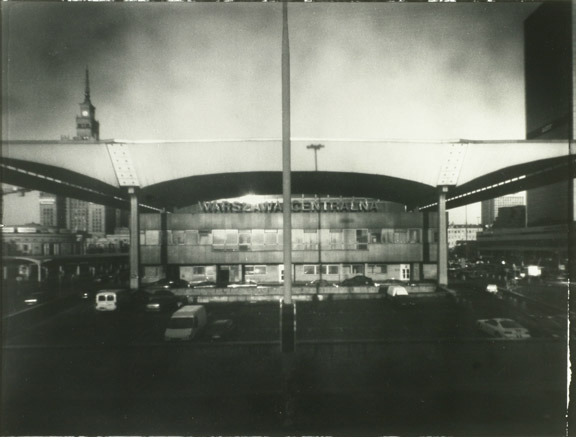
Konrad Pustoła, Dworzec Centralny, 2003, from series "Warsaw",
Mała Gallery in Warsaw, May 2005.
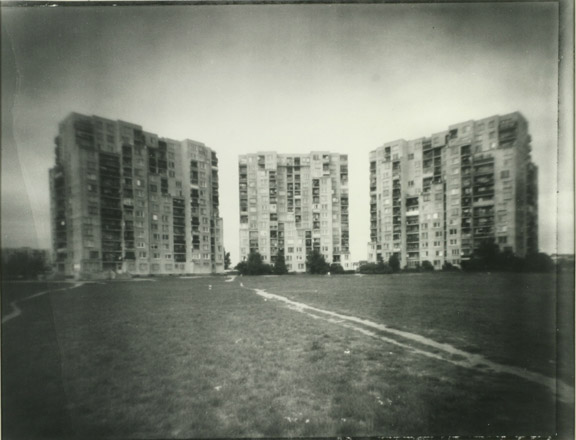
Konrad Pustoła, Targówek, 2002, from series "Warsaw",
Mała Gallery in Warsaw, May 2005.
THE phenomenon of pinhole photography since long interested the Mała Gallery. During the last dozen or so years presented here were exhibitions of the artists like Wiktor Nowotka, Basia Sokołowska, Daniel Kazimierski, Marek Poźniak and Przemek Zajfert or Georgia Krawiec.
It should be said that this apparently simple technique while requiring some practice in experimentation yields very variable and unexpected results. This is why all these artists presented their own, unique propositions and expanded the range of this interesting phenomenon.
It happens that for some artists the pinhole photography becomes a consciously selected method for conveying a particular message or carrying out some art project.
Konrad Pustoła who is fascinated with contemporary town that is for him not only a gaathering of people but also a mosaic of „infinite number of patterns, colours and textures created by centuries-long layers of history”* tries with his almost monochromatic photographs to freeze this continous process.
He calls it „slowing down the perception”*. This is why he is not fascinated by motion, noise, masses – what interested so violently the futirists. Instead he tries to convey a mood of transience and relativity of passing time. This applies equally to already presented set of photographs from untouched by time town of Siena in Italy, where history left its succesive layers and to pictures from Warsaw, the city „sentenced to be new”* because of its tragic and complicated fate.
Unique aesthetics of these photographs is not only a result of deliberate use of a particular tool and one of the simplest photographic techniques but also of presence of unexpected, incidental stratifications, out of focus areas and painterly effects making these pictures look more like paintings or cheap prints than hyperrealistic recording of surrounding us reality.
The town, even so monotonous and colourless in reference to large areas of block housings (e.g. district of Wawrzyszew) becomes on Konrad Pustola’s photographs almost a stage decoration for a play being constantly performed before our eyes and which is putting down consecutive layers of passing time.
Marek Grygiel
April 25th, 2005
* quotation from the text of Konrad Pustoła
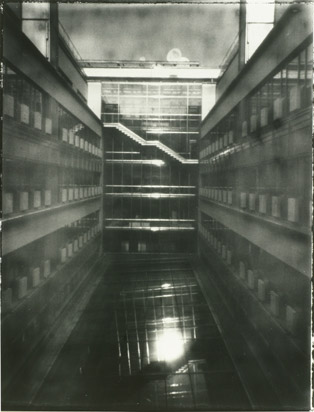 |
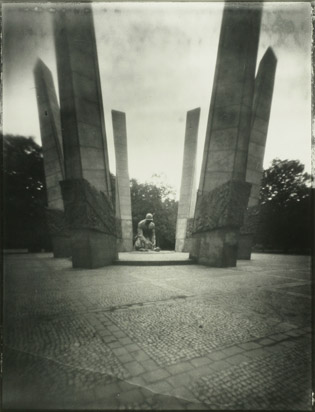 |
|
| Konrad Pustoła, Stock Exchange, 2003 | Konrad Pustoła, The soldier, 2002 | |
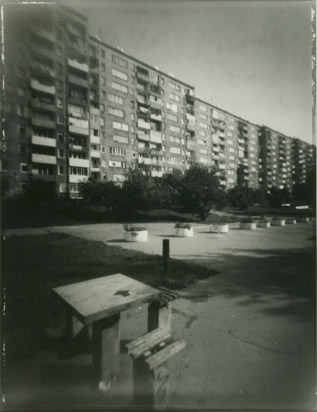 |
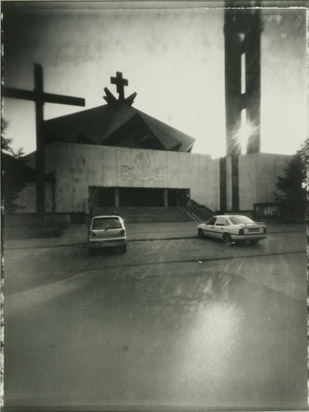 |
|
| Konrad Pustoła, Wawrzyszew, 2002 | Konrad Pustoła, St Zygmunt Church, 2002 | |
| From series "Warsaw", Mała Gallery ZPAF-CSW w Warszawie, May 2005. | ||
KONRAD PUSTOŁA
born 1976
Graduated from the Department of Economics of Warsaw University. Studies photography
at the State Higher School of Film, Theatre and Televison in Łódź. Co-founder
and vice-president of the Photographers’ Association „poniekąd”.
From 2000 to 2002 member of photography team of web site Latarnik. Creative
director of social-political quarterly „Krytyka Polityczna”.
Solo exhibitions
2001 - Ale Meksyk! – Muzeum im. I. Paderewskiego, Warszawa
2002 - Sanna – Festiwal Fotografii Czarno-Białej, schronisko „Kalatówki”,
Zakopane
2003 - Ale Meksyk! – Dom Darmstadt, Płock
2004 - Siena – Miesiąc Fotografii w Krakowie, Instytut Włoski
2004 - Siena – Galeria Wizytująca, Warszawa
2004 - Warszawa – Lumo 04 Photographic Triennial, Jyvaskyla, Finlandia
2005 - Warszawa – KULTURJAHR der ZEHN, Berlin, Niemcy
Group exhibitions
1998 - Miasto – Uniwersytet Warszawski, Warszawa
2000 - Supermarket sztuki – Galeria DAP, Warszawa
2001 - W ciągu pieszym – mur kościoła Św. Anny, Warszawa
2001 - Warszawa od Świtu do zmierzchu – galeria SPAF, Warszawa
2002 - Powiększenie. Fotografia w czasach zgiełku – PKiN, Warszawa
Earlier in FOTOTAPETA: (in Polish)
In FOTOTAPETA also:
In FOTOTAPETA also:
Copyright © 1997-2025 Marek Grygiel / Copyright for www edition © 1997-2025 Zeta-Media Inc.